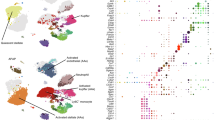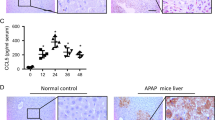Abstract
Due to their broad functional plasticity, myeloid cells contribute to both liver injury and recovery during acetaminophen overdose-induced acute liver injury (APAP-ALI). A comprehensive understanding of cellular diversity and intercellular crosstalk is essential to elucidate the mechanisms and to develop therapeutic strategies for APAP-ALI treatment. Here, we identified the function of IFN-I in the myeloid compartment during APAP-ALI. Utilizing single-cell RNA sequencing, we characterized the cellular atlas and dynamic progression of liver CD11b+ cells post APAP-ALI in WT and STAT2 T403A mice, which was further validated by immunofluorescence staining, bulk RNA-seq, and functional experiments in vitro and in vivo. We identified IFN-I-dependent transcriptional programs in a three-way communication pathway that involved IFN-I synthesis in intermediate restorative macrophages, leading to CSF-1 production in aging neutrophils that ultimately enabled Trem2+ restorative macrophage maturation, contributing to efficient liver repair. Overall, we uncovered the heterogeneity of hepatic myeloid cells in APAP-ALI at single-cell resolution and the therapeutic potential of IFN-I in the treatment of APAP-ALI.
This is a preview of subscription content, access via your institution
Access options
Subscribe to this journal
Receive 12 digital issues and online access to articles
$119.00 per year
only $9.92 per issue
Buy this article
- Purchase on Springer Link
- Instant access to full article PDF
Prices may be subject to local taxes which are calculated during checkout







Similar content being viewed by others
References
Horvatits T, Drolz A, Trauner M, Fuhrmann V. Liver injury and failure in critical illness. Hepatology. 2019;70:2204–15. https://doi.org/10.1002/hep.30824.
McGill MR, Sharpe MR, Williams CD, Taha M, Curry SC, Jaeschke H. The mechanism underlying acetaminophen-induced hepatotoxicity in humans and mice involves mitochondrial damage and nuclear DNA fragmentation. J Clin Invest. 2012;122:1574–83. https://doi.org/10.1172/JCI59755.
Prescott LF, Illingworth RN, Critchley JA, Stewart MJ, Adam RD, Proudfoot AT. Intravenous N-acetylcystine: the treatment of choice for paracetamol poisoning. Br Med J. 1979;2:1097–100. https://doi.org/10.1136/bmj.2.6198.1097.
Chopyk DM, Grakoui A. Contribution of the intestinal microbiome and gut barrier to hepatic disorders. Gastroenterology. 2020;159:849–63. https://doi.org/10.1053/j.gastro.2020.04.077.
Benard A, Sakwa I, Schierloh P, Colom A, Mercier I, Tailleux L, et al. B cells producing type I IFN modulate macrophage polarization in tuberculosis. Am J Respir Crit Care Med. 2018;197:801–13. https://doi.org/10.1164/rccm.201707-1475OC.
Kumaran Satyanarayanan S, El Kebir D, Soboh S, Butenko S, Sekheri M, Saadi J, et al. IFN-beta is a macrophage-derived effector cytokine facilitating the resolution of bacterial inflammation. Nat Commun. 2019;10:3471. https://doi.org/10.1038/s41467-019-10903-9.
Kubes P, Mehal WZ. Sterile inflammation in the liver. Gastroenterology. 2012;143:1158–72. https://doi.org/10.1053/j.gastro.2012.09.008.
Vannella KM, Wynn TA. Mechanisms of organ injury and repair by macrophages. Annu Rev Physiol. 2017;79:593–617. https://doi.org/10.1146/annurev-physiol-022516-034356.
Yang W, Tao Y, Wu Y, Zhao X, Ye W, Zhao D, et al. Neutrophils promote the development of reparative macrophages mediated by ROS to orchestrate liver repair. Nat Commun. 2019;10:1076. https://doi.org/10.1038/s41467-019-09046-8.
Perugorria MJ, Esparza-Baquer A, Oakley F, Labiano I, Korosec A, Jais A, et al. Non-parenchymal TREM-2 protects the liver from immune-mediated hepatocellular damage. Gut. 2019;68:533–46. https://doi.org/10.1136/gutjnl-2017-314107.
Triantafyllou E, Pop OT, Possamai LA, Wilhelm A, Liaskou E, Singanayagam A, et al. MerTK expressing hepatic macrophages promote the resolution of inflammation in acute liver failure. Gut. 2018;67:333–47. https://doi.org/10.1136/gutjnl-2016-313615.
Wang Y, Song Q, Huang W, Lin Y, Wang X, Wang C, et al. A virus-induced conformational switch of STAT1-STAT2 dimers boosts antiviral defenses. Cell Res. 2021;31:206–18. https://doi.org/10.1038/s41422-020-0386-6.
Sierro F, Evrard M, Rizzetto S, Melino M, Mitchell AJ, Florido M, et al. A Liver Capsular Network of monocyte-derived macrophages restricts hepatic dissemination of intraperitoneal bacteria by neutrophil recruitment. Immunity. 2017;47:374–88.e6. https://doi.org/10.1016/j.immuni.2017.07.018.
Woolbright BL, Jaeschke H. Role of the inflammasome in acetaminophen-induced liver injury and acute liver failure. J Hepatol. 2017;66:836–48. https://doi.org/10.1016/j.jhep.2016.11.017.
Hassani M, Hellebrekers P, Chen N, van Aalst C, Bongers S, Hietbrink F, et al. On the origin of low-density neutrophils. J Leukoc Biol. 2020;107:809–18. https://doi.org/10.1002/JLB.5HR0120-459R.
Zhang D, Chen G, Manwani D, Mortha A, Xu C, Faith JJ, et al. Neutrophil ageing is regulated by the microbiome. Nature. 2015;525:528–32. https://doi.org/10.1038/nature15367.
Xie X, Shi Q, Wu P, Zhang X, Kambara H, Su J, et al. Single-cell transcriptome profiling reveals neutrophil heterogeneity in homeostasis and infection. Nat Immunol. 2020;21:1119–33. https://doi.org/10.1038/s41590-020-0736-z.
Trapnell C, Cacchiarelli D, Grimsby J, Pokharel P, Li S, Morse M, et al. The dynamics and regulators of cell fate decisions are revealed by pseudotemporal ordering of single cells. Nat Biotechnol. 2014;32:381–6. https://doi.org/10.1038/nbt.2859.
Zigmond E, Samia-Grinberg S, Pasmanik-Chor M, Brazowski E, Shibolet O, Halpern Z, et al. Infiltrating monocyte-derived macrophages and resident kupffer cells display different ontogeny and functions in acute liver injury. J Immunol. 2014;193:344–53. https://doi.org/10.4049/jimmunol.1400574.
Pervolaraki K, Rastgou Talemi S, Albrecht D, Bormann F, Bamford C, Mendoza JL, et al. Differential induction of interferon stimulated genes between type I and type III interferons is independent of interferon receptor abundance. PLoS Pathog. 2018;14:e1007420. https://doi.org/10.1371/journal.ppat.1007420.
Wang Y, Nan J, Willard B, Wang X, Yang J, Stark GR. Negative regulation of type I IFN signaling by phosphorylation of STAT2 on T387. EMBO J. 2017;36:202–12. https://doi.org/10.15252/embj.201694834.
Lex A, Gehlenborg N, Strobelt H, Vuillemot R, Pfister H. UpSet: visualization of intersecting sets. IEEE Trans Vis Comput Graph. 2014;20:1983–92. https://doi.org/10.1109/tvcg.2014.2346248.
Hamilton TA, Zhao C, Pavicic PG Jr., Datta S. Myeloid colony-stimulating factors as regulators of macrophage polarization. Front Immunol. 2014;5:554. https://doi.org/10.3389/fimmu.2014.00554.
Jin S, Guerrero-Juarez CF, Zhang L, Chang I, Ramos R, Kuan CH, et al. Inference and analysis of cell-cell communication using CellChat. Nat Commun. 2021;12:1088. https://doi.org/10.1038/s41467-021-21246-9.
Scutera S, Fraone T, Musso T, Cappello P, Rossi S, Pierobon D, et al. Survival and migration of human dendritic cells are regulated by an IFN-alpha-inducible Axl/Gas6 pathway. J Immunol. 2009;183:3004–13. https://doi.org/10.4049/jimmunol.0804384.
Braza MS, Conde P, Garcia M, Cortegano I, Brahmachary M, Pothula V, et al. Neutrophil derived CSF1 induces macrophage polarization and promotes transplantation tolerance. Am J Transplant. 2018;18:1247–55. https://doi.org/10.1111/ajt.14645.
Mufarrege EF, Haile LA, Etcheverrigaray M, Verthelyi DI. Multiplexed gene expression as a characterization of bioactivity for interferon beta (IFN-beta) biosimilar candidates: Impact of Innate Immune Response Modulating Impurities (IIRMIs). AAPS J. 2019;21:26. https://doi.org/10.1208/s12248-019-0300-7.
Stutchfield BM, Antoine DJ, Mackinnon AC, Gow DJ, Bain CC, Hawley CA, et al. CSF1 restores innate immunity after liver injury in mice and serum levels indicate outcomes of patients with acute liver failure. Gastroenterology. 2015;149:1896–909.e14. https://doi.org/10.1053/j.gastro.2015.08.053.
Ushach I, Zlotnik A. Biological role of granulocyte macrophage colony-stimulating factor (GM-CSF) and macrophage colony-stimulating factor (M-CSF) on cells of the myeloid lineage. J Leukoc Biol. 2016;100:481–9. https://doi.org/10.1189/jlb.3RU0316-144R.
Aibar S, Gonzalez-Blas CB, Moerman T, Huynh-Thu VA, Imrichova H, Hulselmans G, et al. SCENIC: single-cell regulatory network inference and clustering. Nat Methods. 2017;14:1083–6. https://doi.org/10.1038/nmeth.4463.
Lazear HM, Lancaster A, Wilkins C, Suthar MS, Huang A, Vick SC, et al. IRF-3, IRF-5, and IRF-7 coordinately regulate the type I IFN response in myeloid dendritic cells downstream of MAVS signaling. PLoS Pathog. 2013;9:e1003118. https://doi.org/10.1371/journal.ppat.1003118.
Wen Y, Lambrecht J, Ju C, Tacke F. Hepatic macrophages in liver homeostasis and diseases-diversity, plasticity and therapeutic opportunities. Cell Mol Immunol. 2021;18:45–56. https://doi.org/10.1038/s41423-020-00558-8.
Mossanen JC, Krenkel O, Ergen C, Govaere O, Liepelt A, Puengel T, et al. Chemokine (C-C motif) receptor 2-positive monocytes aggravate the early phase of acetaminophen-induced acute liver injury. Hepatology. 2016;64:1667–82. https://doi.org/10.1002/hep.28682.
Kolodziejczyk AA, Federici S, Zmora N, Mohapatra G, Dori-Bachash M, Hornstein S, et al. Acute liver failure is regulated by MYC- and microbiome-dependent programs. Nat Med. 2020;26:1899–911. https://doi.org/10.1038/s41591-020-1102-2.
Ramachandran P, Dobie R, Wilson-Kanamori JR, Dora EF, Henderson BEP, Luu NT, et al. Resolving the fibrotic niche of human liver cirrhosis at single-cell level. Nature. 2019;575:512–8. https://doi.org/10.1038/s41586-019-1631-3.
Zhang Q, He Y, Luo N, Patel SJ, Han Y, Gao R, et al. Landscape and dynamics of single immune cells in hepatocellular carcinoma. Cell. 2019;179:829–45.e20. https://doi.org/10.1016/j.cell.2019.10.003.
Ng CT, Mendoza JL, Garcia KC, Oldstone MB. Alpha and beta type 1 interferon signaling: passage for diverse biologic outcomes. Cell. 2016;164:349–52. https://doi.org/10.1016/j.cell.2015.12.027.
Jaitin DA, Roisman LC, Jaks E, Gavutis M, Piehler J, Van der Heyden J, et al. Inquiring into the differential action of interferons (IFNs): an IFN-alpha2 mutant with enhanced affinity to IFNAR1 is functionally similar to IFN-beta. Mol Cell Biol. 2006;26:1888–97. https://doi.org/10.1128/mcb.26.5.1888-1897.2006.
Saraiva M, O’Garra A. The regulation of IL-10 production by immune cells. Nat Rev Immunol. 2010;10:170–81. https://doi.org/10.1038/nri2711.
Sharpe AH, Wherry EJ, Ahmed R, Freeman GJ. The function of programmed cell death 1 and its ligands in regulating autoimmunity and infection. Nat Immunol. 2007;8:239–45. https://doi.org/10.1038/ni1443.
Ng CT, Nayak BP, Schmedt C, Oldstone MB. Immortalized clones of fibroblastic reticular cells activate virus-specific T cells during virus infection. Proc Natl Acad Sci USA. 2012;109:7823–8. https://doi.org/10.1073/pnas.1205850109.
Butenko S, Satyanarayanan SK, Assi S, Schif-Zuck S, Sher N, Ariel A. Transcriptomic analysis of monocyte-derived non-phagocytic macrophages favors a role in limiting tissue repair and fibrosis. Front Immunol. 2020;11:405. https://doi.org/10.3389/fimmu.2020.00405.
Butenko S, Ben Jashar N, Sheffer T, Sabo E, Schif-Zuck S, Ariel A. ACKR2 limits skin fibrosis and hair loss through IFN-β. FASEB J. 2021;35:e21917. https://doi.org/10.1096/fj.202002395RR.
Marwick JA, Mills R, Kay O, Michail K, Stephen J, Rossi AG, et al. Neutrophils induce macrophage anti-inflammatory reprogramming by suppressing NF-kappaB activation. Cell Death Dis. 2018;9:665. https://doi.org/10.1038/s41419-018-0710-y.
Aswad M, Assi S, Schif-Zuck S, Ariel A. CCL5 promotes resolution-phase macrophage reprogramming in concert with the atypical chemokine receptor D6 and apoptotic polymorphonuclear cells. J Immunol. 2017;199:1393–404. https://doi.org/10.4049/jimmunol.1502542.
Williams JC, Craven RR, Earp HS, Kawula TH, Matsushima GK. TAM receptors are dispensable in the phagocytosis and killing of bacteria. Cell Immunol. 2009;259:128–34. https://doi.org/10.1016/j.cellimm.2009.06.006.
Lumbroso D, Soboh S, Maimon A, Schif-Zuck S, Ariel A, Burstyn-Cohen T. Macrophage-derived protein S facilitates apoptotic polymorphonuclear cell clearance by resolution phase macrophages and supports their reprogramming. Front Immunol. 2018;9:358. https://doi.org/10.3389/fimmu.2018.00358.
Moore RN, Pitruzzello FJ, Robinson RM, Rouse BT. Interferon produced endogenously in response to CSF-1 augments the functional differentiation of progeny macrophages. J Leukoc Biol. 1985;37:659–64. https://doi.org/10.1002/jlb.37.5.659.
Fleetwood AJ, Dinh H, Cook AD, Hertzog PJ, Hamilton JA. GM-CSF- and M-CSF-dependent macrophage phenotypes display differential dependence on type I interferon signaling. J Leukoc Biol. 2009;86:411–21. https://doi.org/10.1189/jlb.1108702.
Siren J, Pirhonen J, Julkunen I, Matikainen S. IFN-alpha regulates TLR-dependent gene expression of IFN-alpha, IFN-beta, IL-28, and IL-29. J Immunol. 2005;174:1932–7. https://doi.org/10.4049/jimmunol.174.4.1932.
Honda K, Takaoka A, Taniguchi T. Type I interferon [corrected] gene induction by the interferon regulatory factor family of transcription factors. Immunity. 2006;25:349–60. https://doi.org/10.1016/j.immuni.2006.08.009.
Nan J, Wang Y, Yang J, Stark GR. IRF9 and unphosphorylated STAT2 cooperate with NF-kappaB to drive IL6 expression. Proc Natl Acad Sci USA. 2018;115:3906–11. https://doi.org/10.1073/pnas.1714102115.
Zhang L, Pavicic PG Jr., Datta S, Song Q, Xu X, Wei W, et al. Unfolded protein response differentially regulates TLR4-induced cytokine expression in distinct macrophage populations. Front Immunol. 2019;10:1390. https://doi.org/10.3389/fimmu.2019.01390.
Funding
This work was supported by the Key R&D Program of Shandong Province (2020CXGC010503), Shandong Provincial Key Laboratory Platform Project (2021ZDSYS11), and Major Program of National Natural Science Foundation of China (81991525).
Author information
Authors and Affiliations
Contributions
TH, CZ and JY directed all aspects of the project. QS, SD, XX, PP, YZhao, SL, ZZ, PH, PJ, YQ, WL, JZ, YX, JX, ZW, LW, MZ and YZhang performed the experiments. XL, QS and CY analyzed the seq data with significant contributions from XL in data visualization. XZ and CL discussed the clinical features of liver injury and reviewed the pathology sections. QS, CZ, JY and TH wrote the manuscript. YW, GS, YL and GRS read the manuscript and provided useful comments.
Corresponding authors
Ethics declarations
Competing interests
The authors declare no competing interests.
Supplementary information
Rights and permissions
Springer Nature or its licensor (e.g. a society or other partner) holds exclusive rights to this article under a publishing agreement with the author(s) or other rightsholder(s); author self-archiving of the accepted manuscript version of this article is solely governed by the terms of such publishing agreement and applicable law.
About this article
Cite this article
Song, Q., Datta, S., Liang, X. et al. Type I interferon signaling facilitates resolution of acute liver injury by priming macrophage polarization. Cell Mol Immunol 20, 143–157 (2023). https://doi.org/10.1038/s41423-022-00966-y
Received:
Accepted:
Published:
Issue Date:
DOI: https://doi.org/10.1038/s41423-022-00966-y



